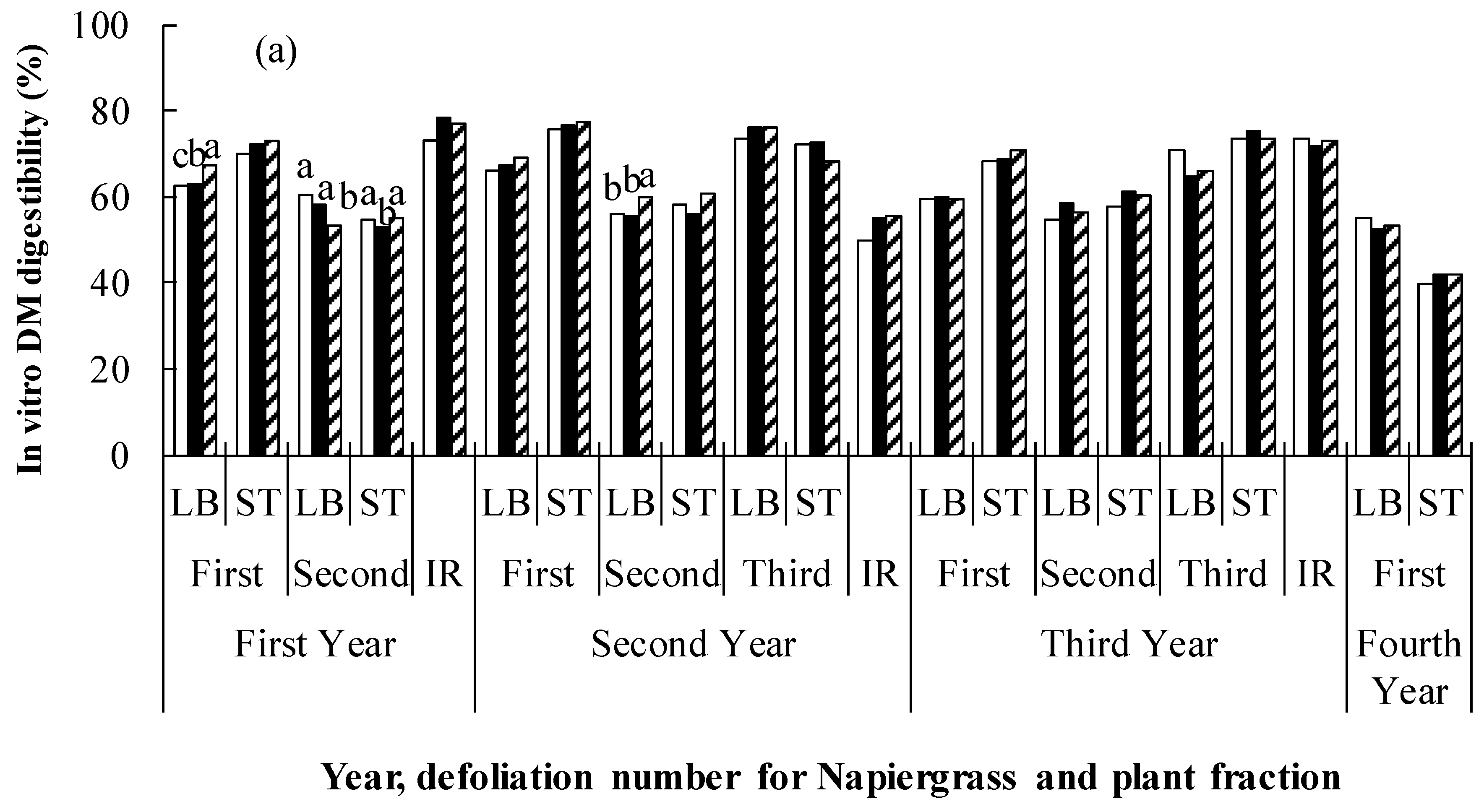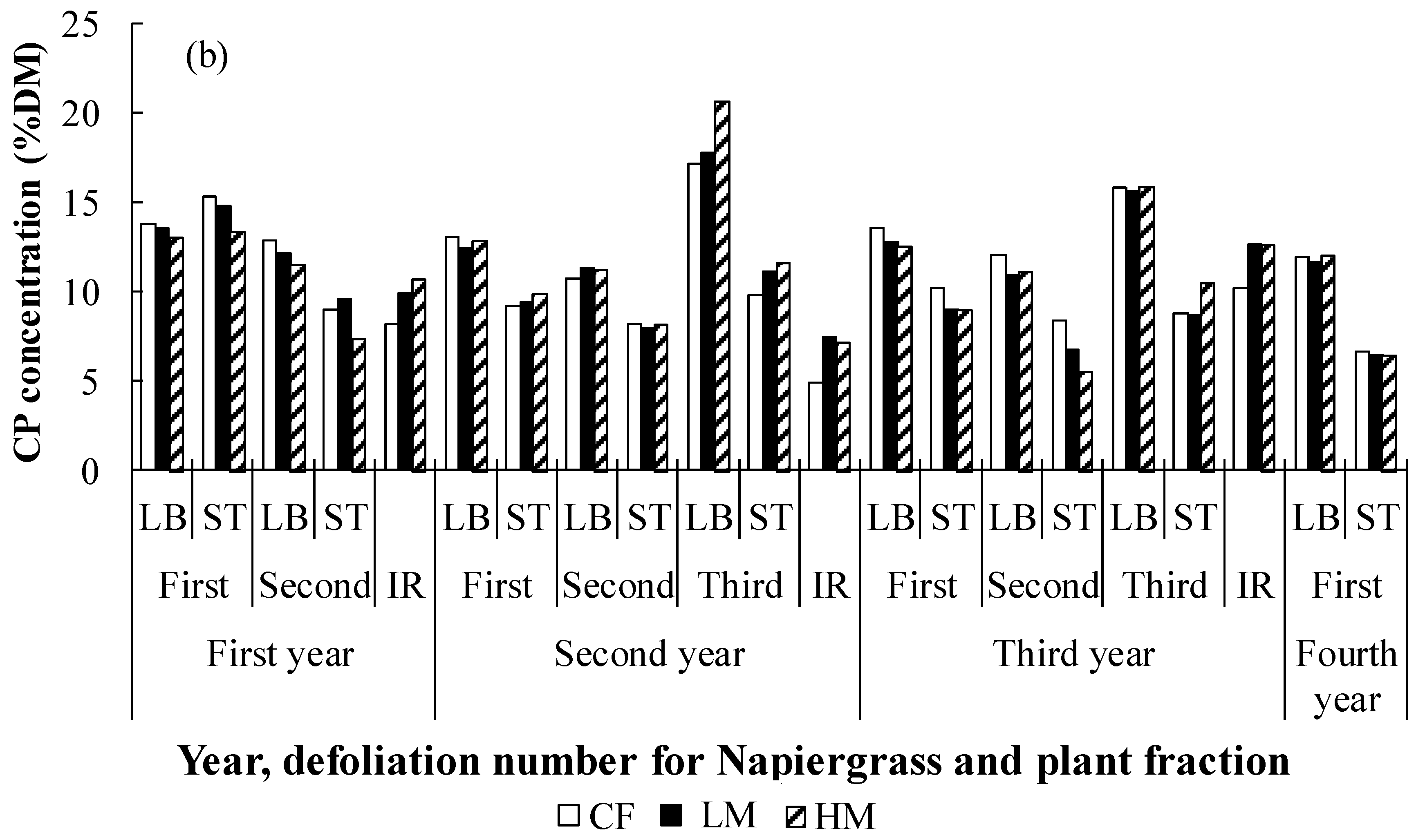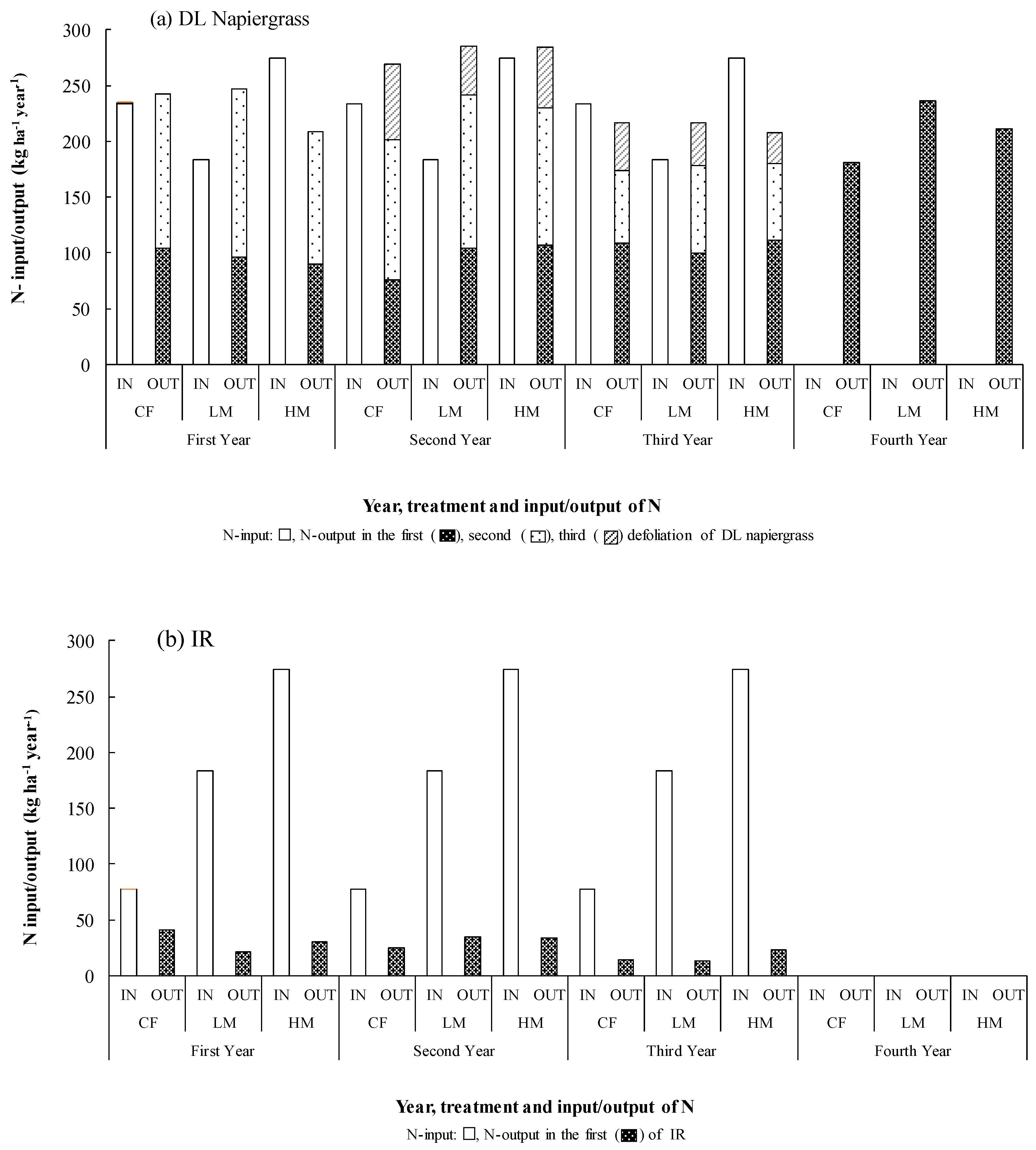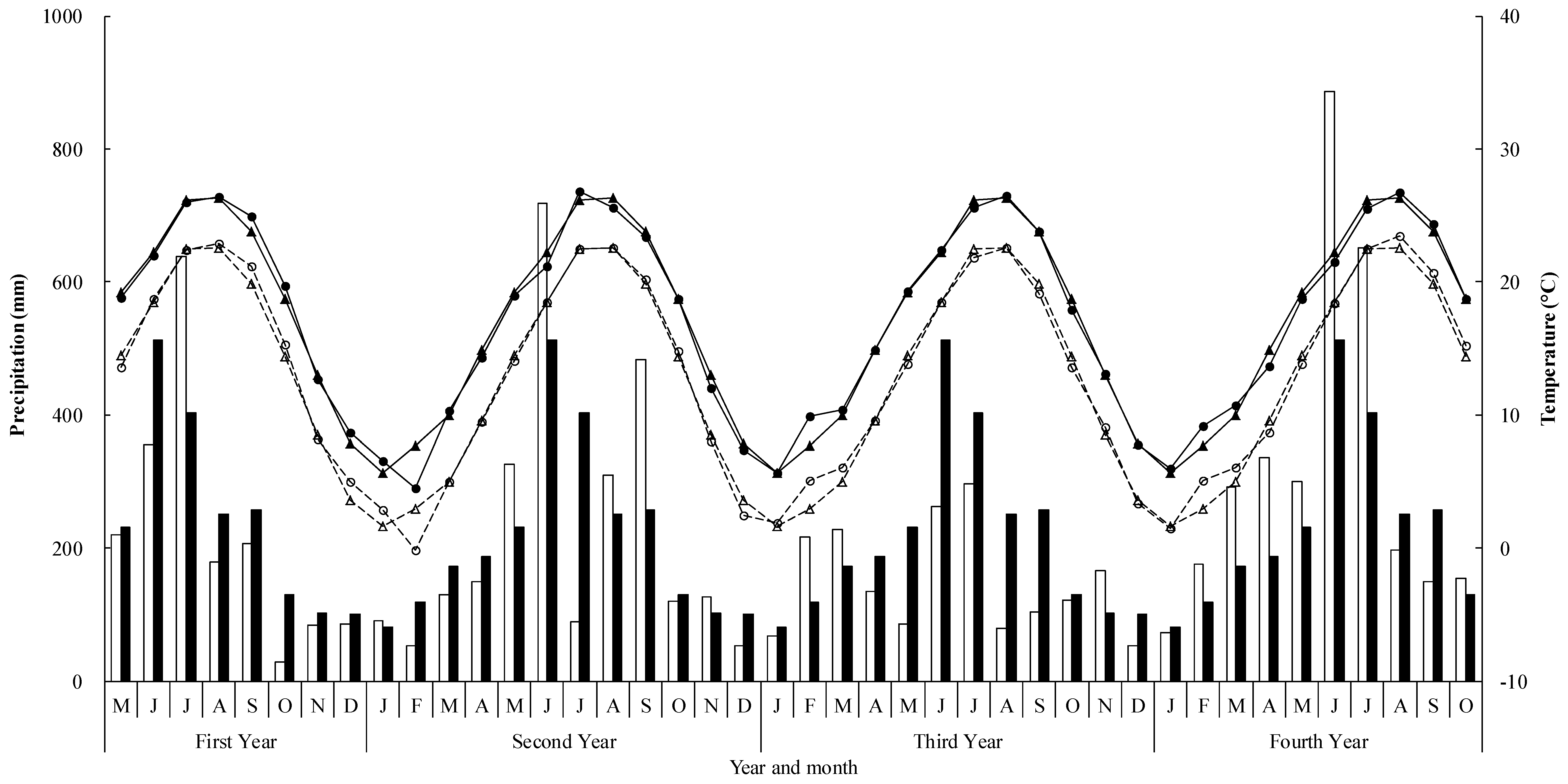Effect of Repeated Application of Manure on Herbage Yield, Quality and Wintering Ability during Cropping of Dwarf Napiergrass with Italian Ryegrass in Hilly Southern Kyushu, Japan
Abstract
:1. Introduction
2. Results
2.1. Soil Nutrient Status
2.2. Growth Attributes
2.3. DM Yield
2.4. Overwintering Ability
2.5. Herbage Quality Attributes
2.6. Input and Output of Total N
3. Discussion
4. Materials and Methods
4.1. Experimental Site, Climatic Conditions, and Grass Species
4.2. Experimental Design and Treatments
4.3. Planting and Management Practices
4.4. Data Collection and Analytical Procedures
4.4.1. Soil Sampling and Chemical Analysis
4.4.2. Growth Attributes and DM Yield
4.4.3. Overwintering Ability
4.4.4. Determination of Herbage Quality
4.5. Statistical Analysis
5. Conclusions
Acknowledgments
Author Contributions
Conflicts of Interest
References
- Ishii, Y.; Mukhtar, M.; Idota, S.; Fukuyama, K. Rotational grazing system for beef cows on dwarf napiergrass pasture oversown with Italian ryegrass for 2 years after establishment. Grassl. Sci. 2005, 51, 223–234. [Google Scholar] [CrossRef]
- Ishii, Y.; Hamano, K.; Kang, D.J.; Rengsirikul, K.; Idota, S.; Nishiwaki, A. C4-Napier grass cultivation for cadmium phytoremediation activity and organic livestock farming in Kyushu, Japan. J. Agric. Sci. Technol. A 2013, 3, 321–330. [Google Scholar]
- Ishii, Y.; Dong-Jing, K.; Yamano, A.; Idota, S.; Fukuyama, K. Adaptability and extension activity of dwarf napiergrass in southern Kyushu and elsewhere since its introduction to Japan 15 years ago. In Development and Impact of Sown Temperate Species, Proceedings of the 22nd International Grassland Congress, Sydney, Australia, 15–19 September 2013; New South Wales Department of Primary Industry: Orange New South Wales, Australia, 2013. [Google Scholar]
- Utamy, R.F.; Ishii, Y.; Idota, S.; Harada, N.; Fukuyama, K. Adaptability of dwarf napiergrass under cut-and-carry and grazing systems for smallholder beef farmers in southern Kyushu, Japan. J. Warm Reg. Soc. Anim. Sci. Jpn. 2011, 54, 65–76. [Google Scholar] [CrossRef]
- Hasyim, H.; Wadi, A.; Ishii, Y.; Idota, S.; Fukuyama, K. Production and quality in dwarf napier grass pasture fertilized by digested effluent of manure under two-years of dairy cow-grazing in warm regions of Japan. Am. J. Appl. Sci. 2016, 13, 479–489. [Google Scholar] [CrossRef]
- Jones, C.A. C4 Grasses and Cereals; John Wiley and Sons: New York, NY, USA, 1985; p. 1189. [Google Scholar]
- Hasyim, H.; Ishii, Y.; Wadi, A.; Idota, S. Effect of digested effluent of manure on soil nutrient content and production of dwarf Napiergrass in southern Kyushu, Japan. J. Agron. 2014, 13, 1–11. [Google Scholar] [CrossRef]
- Singh, R.B. Environmental consequences of agricultural development: A case study from the Green Revolution state of Haryana, India. Agric. Ecosyst. Environ. 2000, 82, 97–103. [Google Scholar] [CrossRef]
- Prasad, P.V.V.; Satyanarayana, V.; Murthy, V.R.K.; Boote, K.J. Maximizing yields in rice-groundnut cropping sequence through integrated nutrient management. Field Crops Res. 2002, 75, 9–21. [Google Scholar] [CrossRef]
- Wopereis, M.C.S.; Tamélokpo, A.; Ezui, K.; Gnakpénou, D.; Fofana, B.; Breman, H. Mineral fertilizer management of maize on farmer fields differing in organic inputs in the West African savanna. Field Crops Res. 2006, 96, 355–362. [Google Scholar] [CrossRef]
- Fageria, N.K.; Baligar, V.C.; Edwards, D.G. Soil-plant-nutrient relationship at low pH stress. In Growth and Mineral Nutrition of Field Crops, 3rd ed.; CRC Press, Taylor and Francis Group: New York, NY, USA, 1990; pp. 125–174. [Google Scholar]
- Dormaar, J.F.; Lindwall, C.W.; Kozub, G.C. Effectiveness of manure and commercial fertilizer in restoring productivity of an artificially eroded dark brown Chernozemic soil under dryland conditions. Can. J. Soil Sci. 1988, 68, 669–679. [Google Scholar] [CrossRef]
- Larney, F.J.; Janzen, H.H. Restoration of productivity to a desurfaced soil with livestock manure, crop residue and fertilizer amendments. Agron. J. 1996, 88, 921–927. [Google Scholar] [CrossRef]
- Larney, F.J.; Olson, B.M.; Janzen, H.H.; Lindwall, C.W. Early impact of topsoil removal and soil amendments on crop productivity. Agron. J. 2000, 92, 948–956. [Google Scholar] [CrossRef]
- Chang, C.; Sommerfeldt, T.G.; Entz, T. Soil chemistry after eleven annual applications of cattle feedlot manure. J. Environ. Qual. 1991, 20, 475–480. [Google Scholar] [CrossRef]
- Kingery, W.L.; Wood, C.W.; Delaney, D.P.; Williams, J.C.; Mullins, G.L. Impact of long-term land application of broiler litter on environmentally related soil properties. J. Environ. Qual. 1994, 23, 139–147. [Google Scholar] [CrossRef]
- Dormaar, J.F.; Chang, C. Effect of 20 annual applications of excess feedlot manure on labile soil phosphorus. Can. J. Soil Sci. 1995, 75, 507–512. [Google Scholar] [CrossRef]
- Eghball, B.; Power, J.F. Phosphorus- and nitrogen-based manure and compost applications corn production and soil phosphorus. Soil Sci. Soc. Am. J. 1999, 63, 895–901. [Google Scholar] [CrossRef]
- Schmidt, L.; Warnstorff, K.; Dörfel, H.; Leinweber, P.; Lange, H.; Merbach, W. The influence of fertilization and rotation on soil organic matter and plant yields in the long-term Eternal Rye trial in Halle (Saale), Germany. J. Plant Nutr. Soil Sci. 2000, 163, 639–648. [Google Scholar] [CrossRef]
- Sommerfeldt, T.G.; Chang, C. Changes in soil properties under annual applications of feedlot manure and different tillage practices. Soil Sci. Soc. Am. J. 1985, 49, 983–987. [Google Scholar] [CrossRef]
- Benbi, D.K.; Biswas, C.R.; Bawa, S.S.; Kumar, K. Influence of farmyard manure, inorganic fertilizers and weed control practices on some soil physical properties in a long-term experiment. Soil Use Manag. 1998, 14, 52–54. [Google Scholar] [CrossRef]
- Pieterse, P.A.; Rethman, N.F.G. The influence of nitrogen fertilisation and soil pH on the dry matter yield and forage quality of Pennisetum purpureum and P. purpureum × P. glaucum hybrids. Trop. Grassl. 2002, 36, 83–89. [Google Scholar]
- Sunusi, A.A.; Ito, K.; Tanaka, S.; Ishii, Y.; Ueno, M.; Miyagi, E. Yield and digestibility of napiergrass (Pennisetum purpureum Schumach) as affected by the level of manure input and the cutting interval. Jpn. J. Grassl. Sci. 1997, 43, 209–217. [Google Scholar] [CrossRef]
- Tessema, Z.; Baars, R.M.T.; Yami, A. Effect of plant height at cutting and fertilizer on growth of Napier grass (Pennisetum purpureum). Trop. Sci. 2003, 42, 57–61. [Google Scholar]
- Wadi, A.; Ishii, Y.; Idota, S. Effects of cutting interval and cutting height on dry matter yield and overwintering ability at the established year in Pennisetum species. Plant Prod. Sci. 2004, 7, 88–96. [Google Scholar] [CrossRef]
- Ahmad, T.; Butt, N.M. Effect of precipitation and nitrogen fertilizer on napiergrass. In Proceedings of the 15th International Grassland Congress, Kyoto, Japan, 24 August–7 September 1985. [Google Scholar]
- Chang, C.; Entz, T. Nitrate leaching losses under repeated cattle feedlot manure applications in southern Alberta. J. Environ. Qual. 1996, 25, 145–153. [Google Scholar] [CrossRef]
- Sweeten, J.M. Cattle feedlot manure and wastewater management practices. In Animal Waste Utilization: Effective Use of Manure as a Soil Resource; Hatfield, J.L., Stewart, B.A., Eds.; CRC Press LLC: Boca Raton, FL, USA, 1998; p. 125155. [Google Scholar]
- Torstensson, G.; Aronsson, H. Nitrogen leaching and crop availability in manured catch crop systems in Sweden. Nutr. Cycl. Agroecosyt. 2000, 56, 139–152. [Google Scholar] [CrossRef]
- Chang, C.; Janzen, H.H.; Cho, C.M. Nitrous oxide emission from long-term manured soils. Soil Sci. Soc. Am. J. 1998, 62, 677–682. [Google Scholar] [CrossRef]
- King, L.D.; Burns, J.C.; Westerman, P.W. Long-term swine lagoon effluent applications on ‘Coastal’ Bermudagrass: II. Effect on nutrient accumulation in soil. J. Environ. Qual. 1990, 19, 756–760. [Google Scholar] [CrossRef]
- Snyder, C.S. Fertilization. In Forages Volume II, 6th ed.; Barnes, R.F., Nelson, C.J., Moore, K.J., Collins, M., Eds.; Blackwell Publishing: Ames, IA, USA, 2007; pp. 355–377. [Google Scholar]
- Rahman, M.M.; Ishii, Y.; Niimi, M.; Kawamura, O. Effects of levels of nitrogen fertilizer on oxalate and some mineral contents in napiergrass (Pennisetum purpureum Schumach). Grassl. Sci. 2008, 54, 146–150. [Google Scholar] [CrossRef]
- Nyaata, O.Z.; O’Neill, M.K.; Dorward, P.T.; Keatinge, J.D.H. Harvesting strategies for improved mixtures of Calliandra and Napier Grass in the central Kenyan highlands. J. Sustain. Agric. 2002, 19, 77–95. [Google Scholar] [CrossRef]
- Tekletsadik, T.; Tudsri, S.; Juntakool, S.; Prasanpanich, S. Effect of dry season cutting management on subsequent forage yield and quality of ruzi (Brachiaria ruziziensis) and dwarf napier (Pennisetum purpureum L.) in Thailand. Kasetsart J. (Nat. Sci.) 2004, 38, 457–467. [Google Scholar]
- Jørgensen, S.T.; Pookpakdi, A.; Tudsri, S.; Stölen, O.; Ortiz, R.; Christiansen, J.L. Cultivar-by-cutting height interactions in Napier grass (Pennisetum purpureum Schumach) grown in a tropical rain-fed environment. Acta Agric. Scand. Sect. B—Plant Soil Sci. 2010, 60, 199–210. [Google Scholar] [CrossRef]
- Banik, P.; Ghosal, P.K.; Sasmal, T.K.; Bhattacharya, S.; Sarkar, B.K.; Bagchi, D.K. Effect of organic and inorganic nutrients for soil quality conservation and yield of rainfed low land rice in sub-tropical plateau region. J. Agron. Crop Sci. 2006, 192, 331–343. [Google Scholar] [CrossRef]
- Boparai, B.S.; Singh, Y.; Sharma, B.D. Effect of green manure (Sesbania aculeate) on physical properties of soil and growth of rice-wheat and maize-wheat cropping system. Int. Agrophys. 1992, 6, 95–101. [Google Scholar]
- Hasyim, H.; Ishii, Y.; Wadi, A.; Sususi, A.A.; Fukagawa, S.; Idota, S. Residual effects of composted digested effluent on growth of dwarf Napier grass in warm regions of Japan. J. Exp. Biol. Agric. Sci. 2016, 74–84. [Google Scholar] [CrossRef]
- Humphreys, L.R. Tropical Pastures and Fodder Crops, 2nd ed.; Longman Scientific & Techinical: London, UK, 1987; pp. 1–154. [Google Scholar]
- Crowder, L.V. Potential of tropical zone cultivated forages. In Potential of the World Forages for Ruminant Animal Productions; Winrock Intern Livestock Research and Training Centre: Morrilton, AR, USA, 1977. [Google Scholar]
- Mohammad, N.; Butt, N.M.; Qamar, I.A. Effect of nitrogen fertilization and harvesting intervals on the yield and nutritional value of napier grass. Pakistan J. Agric. Res. 1988, 9, 478–482. [Google Scholar]
- Utamy, R.F.; Ishii, Y.; Iwamura, K.; Idota, S. Effect of weed control on establishment and herbage production in dwarf Napiergrass. J. Life Sci. 2014, 8, 46–50. [Google Scholar]
- Kobayashi, T.; Nishimura, S. Winter hardiness and carbohydrate reserve of some tropical and subtropical grasses as affected by the final cutting date in autumn. J. Jpn. Grassl. Sci. 1978, 24, 27–33. [Google Scholar]
- Van Soest, P.J. Nutritional Ecology of the Ruminants, 2nd ed.; Comstock Publishing Associates, Cornell University Press: Ithaca, NY, USA, 1994; pp. 1–476. [Google Scholar]
- Ishii, Y.; Ito, K.; Numaguchi, H. Seasonal changes in the dry matter digestibility of individual tillers of napiergrass at two sites of different altitudes. In Proceedings of the 17th International Grassland Congress, Rockhampton, Australia, 18–21 February 1993; pp. 2010–2011. [Google Scholar]
- Fukagawa, S.; Ito, K.; Ishii, Y. Changes in respiratory activity and dry matter disappearance with aging in napiergrass (Pennisetum purpureum Schumach). Jpn. J. Grassl. Sci. 2000, 46, 167–174. (In Japanese) [Google Scholar] [CrossRef]
- Fadare, D.A.; Bamiro, O.A.; Oni, A.O. Energy and cost analysis of organic fertilizer production in Nigeria. Energy 2010, 35, 332–340. [Google Scholar] [CrossRef]
- Japan Meteorology Agency. Available online: http://www.data.jma.go.jp/obd/stats/etrn/ (accessed on 2 November 2010).
- Tarawali, S.A.; Tarawali, G.; Larbi, A.; Hanson, J. Evaluation of Forage Legumes, Grasses and Fodder Trees for Use as Livestock Feed; International Livestock Research Institute: Nairobi, Kenya, 1995; Available online: http://www.plantpath.cornell.edu/mba_project/ciepca/exmats/forage.pdf (accessed on 27 May 2011).
- Goto, I.; Minson, D.J. Prediction of the dry matter digestibility of tropical grasses using pepsin-cellulase assay. Anim. Feed Sci. Technol. 1977, 2, 247–253. [Google Scholar] [CrossRef]
- McDonald, J.H. Handbook of Biological Statistics, 2nd ed.; Sparky House Publishing: Baltimore, MD, USA, 2009; Available online: http://udel.edu/~mcdonald/stattansform.html (accessed on 2 November 2010).





| Month and Year | Treatment ‡ | TN (% DM) | TC (% DM) | CN Ratio |
|---|---|---|---|---|
| May 2007 | CF | 0.48 ± 0.01 | 5.16 ± 0.17 | 10.85 ± 0.08 |
| LM | 0.50 ± 0.01 | 5.30 ± 0.10 | 10.81 ± 0.10 | |
| HM | 0.48 ± 0.04 | 5.17 ± 0.43 | 10.77 ± 0.05 | |
| Significance ‡‡ | NS | NS | NS | |
| October 2010 | CF | 0.57 ± 0.04b | 5.93 ± 0.47b | 10.37 ±0.16a |
| LM | 0.65 ± 0.04a | 6.72 ± 0.53a | 10.32 ± 0.16b | |
| HM | 0.59 ± 0.03b | 6.07 ± 0.27b | 10.25 ± 0.07c | |
| Significance‡‡ | * | * | * |
| Attribute | Treatment † | First Year ‡ | Second Year | Third Year | Fourth Year | ||||||||
|---|---|---|---|---|---|---|---|---|---|---|---|---|---|
| DL Napiergrass | IR | DL Napiergrass | IR | DL Napiergrass | IR | DL Napier-Grass | |||||||
| 1st Defoliation | 2nd Defoliation | 1st Defoliation | 2nd Defoliation | 3rd Defoliation | 1st Defoliation | 2nd Defoliation | 3rd Defoliation | First Defoliation | |||||
| Plant height (cm) | CF | 121 | 155 | 80 | 130 | 158 | 57 | 92 | 130 | 137 | 70 | 54 | 199 |
| LM | 127 | 153 | 61 | 134 | 161 | 53 | 90 | 137 | 126 | 74 | 50 | 207 | |
| HM | 126 | 154 | 69 | 131 | 161 | 52 | 88 | 140 | 124 | 70 | 57 | 205 | |
| Significance †† | NS | NS | NS | NS | NS | NS | NS | NS | NS | NS | NS | NS | |
| Tiller density (No m−2) | CF | 62.9 | 80.0 | 404.7a | 56.0c | 88.2 | 226.7 | 265.7 | 69.9 | 173.0 | 264.7 | 536.3 | 63.9 |
| LM | 57.9 | 78.0 | 288.7b | 61.1a | 79.2 | 218.4 | 254.3 | 72.2 | 174.1 | 242.0 | 586.0 | 57.6 | |
| HM | 61.1 | 76.2 | 240.0b | 60.7b | 82. 9 | 209.0 | 312.0 | 75.1 | 174.1 | 236.3 | 556.7 | 73.8 | |
| Significance | NS | NS | * | * | NS | NS | NS | NS | NS | NS | NS | NS | |
| Percentage of leaf blade | CF | 77.0 | 54.1 | — ** | 76.9 | 58.2 | 89.3c | — | 74.2 | 71.2 | 90.5b | — | 32.1 |
| LM | 80.3 | 52.6 | — | 73.6 | 60.8 | 92.0a | — | 72.4 | 71.2 | 90.5b | — | 31.7 | |
| HM | 82.9 | 54.2 | — | 72.2 | 62.7 | 91.7b | — | 67.4 | 74.2 | 92.9a | — | 25.7 | |
| Significance | NS | NS | NS | NS | * | NS | NS | * | NS | ||||
| Month and Year | Attribute | Treatment † | ||
|---|---|---|---|---|
| CF | LM | HM | ||
| 29 April 2008 | POP (%) | 96.7 ± 5.8 NS †† | 100.0 ± 0.0 | 100.0 ± 0.0 |
| RTN (No. m−2) | 18.2 ± 3.5 NS | 25.0 ± 3.4 | 27.6 ± 3.9 | |
| 18 June 2009 | POP (%) | 93.3 ± 5.8 NS | 100.0 ± 0.0 | 96.7 ± 5.8 |
| RTN (No. m−2) | 30.3± 3.4 NS | 23.9 ± 8.3 | 25.6 ± 4.5 | |
| Species | Treatment † | First Year ‡ | Second Year | Third Year | Fourth Year | Pooled | |||||
|---|---|---|---|---|---|---|---|---|---|---|---|
| First Defoliation | Second Defoliation | First Defoliation | Second Defoliation | Third Defoliation | First Defoliation | Second Defoliation | Third Defoliation | First Defoliation | |||
| DL Napiergrass | CF | 105.2 ± 14.9 | 137.3 ± 29.9 | 76.5 ± 5.3 | 125.1±11.7 | 68.0 ± 9.5 | 109.5 ± 21.4 | 64.6 | 42.6 | 181.2 ± 20.3 | 110.5 ± 11.2 |
| LM | 97.0 ± 12.0 | 150.4 ± 26.2 | 104.7 ± 15.4 | 137.2 ± 3.4 | 43.5 ± 8.9 | 100.3 ± 11.4 | 78.4 | 37.9 | 236.3 ± 44.9 | 118.6 ± 2.5 | |
| HM | 90.8 ± 23.2 | 117.7 ± 9.6 | 107.5 ± 20.3 | 122.6 ± 17.1 | 54.3 ± 18.0 | 111.9 ± 8.0 | 68.6 | 27.8 | 211.7 ± 52.6 | 110.7 ± 12.2 | |
| Significance †† | NS | NS | NS | NS | NS | NS | NS | NS | |||
| IR | CF | 41.5 ± 12.0 | 25.9 ± 1.6 | 15.4 ± 6.3 | 27.6 ± 5.0 | ||||||
| LM | 22.0 ± 4.8 | 35.5 ± 13.6 | 14.4 ± 4.0 | 24.0 ± 5.2 | |||||||
| HM | 31.0 ± 10.8 | 34.5 ± 11.8 | 24.5 ± 2.8 | 30.0 ± 8.3 | |||||||
| Significance | NS | NS | NS | NS | |||||||
© 2018 by the authors. Licensee MDPI, Basel, Switzerland. This article is an open access article distributed under the terms and conditions of the Creative Commons Attribution (CC BY) license (http://creativecommons.org/licenses/by/4.0/).
Share and Cite
Utamy, R.F.; Ishii, Y.; Idota, S.; Khairani, L. Effect of Repeated Application of Manure on Herbage Yield, Quality and Wintering Ability during Cropping of Dwarf Napiergrass with Italian Ryegrass in Hilly Southern Kyushu, Japan. Agronomy 2018, 8, 30. https://doi.org/10.3390/agronomy8030030
Utamy RF, Ishii Y, Idota S, Khairani L. Effect of Repeated Application of Manure on Herbage Yield, Quality and Wintering Ability during Cropping of Dwarf Napiergrass with Italian Ryegrass in Hilly Southern Kyushu, Japan. Agronomy. 2018; 8(3):30. https://doi.org/10.3390/agronomy8030030
Chicago/Turabian StyleUtamy, Renny Fatmyah, Yasuyuki Ishii, Sachiko Idota, and Lizah Khairani. 2018. "Effect of Repeated Application of Manure on Herbage Yield, Quality and Wintering Ability during Cropping of Dwarf Napiergrass with Italian Ryegrass in Hilly Southern Kyushu, Japan" Agronomy 8, no. 3: 30. https://doi.org/10.3390/agronomy8030030





